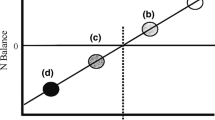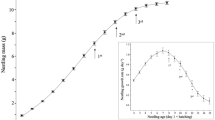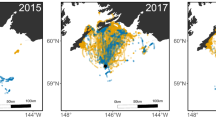Abstract
Food supplementation studies of breeding birds have traditionally concentrated on energetic constraints on breeding performance. It is only recently that the nutritional quality of the prebreeding diet has also been considered influential. We examined the importance of specific nutrients in the prebreeding diet of the Florida scrub-jay (Aphelocoma coerulescens). Birds were provided with one of two supplements (rich in protein and fat or rich in fat only) prior to breeding in 2000 and 2001 and their breeding performance, in relation to unsupplemented (control) birds, was examined. Birds receiving both supplements significantly advanced laying in both years, and increased clutch size in 2000 but not in 2001. Laying date explained variation in clutch size in birds on dietary supplements. Egg mass and volume declined with laying order, irrespective of dietary treatment, but birds on the high fat, high protein diet laid heavier third eggs than controls and this was independent of laying date. Laboratory analysis of 14 abandoned and unhatched eggs revealed that as egg mass increased so did the absolute amount of protein and water while fat content remained relatively fixed. Using these relationships between the masses of egg components and fresh egg mass, we calculated that heavier third eggs laid by birds on high fat and high protein, compared with those laid by controls, contained more water that may be fundamental to chick growth and survival. This is the first demonstration for an avian species that nutritional quality of prebreeding diet can simultaneously influence laying date, clutch size, and egg size and composition.





Similar content being viewed by others
References
Amat JA, Fraga RM, Arroyo GM (2001) Intraclutch egg-size variation and offspring survival in the Kentish Plover Charadrius alexandrinus. Ibis 143:17–23
Anderson VR, Alisauskas RT (2002) Composition and growth of King Eider ducklings in relation to egg size. Auk 119:62–70
Arcese P, Smith JNM (1988) Effects of population density and supplemental food on reproduction in song sparrows. J Anim Ecol 57:119–136
Arnold TW (1994) Effects of supplemental food on egg production in American Coots. Auk 111:337–350
Blomqvist D, Johansson OC, Götmark F (1997) Parental quality and egg size affect chick survival in a precocial bird, the Lapwing Vanellus vanellus. Oecologia 110:18–24
Bolton M (1991) Determinants of chick survival in the lesser black-backed gull: relative contributions of egg size and parental quality. J Anim Ecol 60:949–960
Bolton M, Houston DC, Monaghan P (1992) Nutritional constraints on egg formation in the lesser black-backed gull: an experimental study. J Anim Ecol 61:521–532
Boutin S (1989) Food supplementation experiments with terrestrial vertebrates: patterns, problems, and the future. Can J Zool 68:203–220
Brömsson A von, Jansson C (1980) Effects of food addition to Willow Tit Parus palustris and Crested Tit P. cristatus at the time of breeding. Ornis Scand 11: 173–178
Carey C (1996) Fernale reproductive energetics. In: Carey C (ed) Avian energetics and nutritional ecology. Chapman and Hall, New York, pp 324–374
Carlson A (1989) Courtship feeding and clutch size in Red-backed Shrikes Lanius collurio. Am Nat 133:454–457
Christians JK (2002) Avian egg size: variation within species and inflexibility within individuals. Biol Rev Camb Philos Soc 77:1–26
Clamens A, Isenmann P (1989) Effects of supplemental food on the breeding of blue and great tits in Mediterranean habitats. Ornis Scand 20:36–42
Clifford LD, Anderson DJ (2001) Food limitation explains most clutch size variation in the Nazca booby. J Anim Ecol 70:539–545
Daan S, Dijkstra C, Drent R, Meijer T (1988) Food supply and the annual timing of avian reproduction. Proc Int Ornithol Congr 19:392–407
Davies NB, Lundberg A (1985) The influence of food on time budgets and timing of breeding of the Dunnock Prunella modularis. Ibis 127: 100–110
Ende CN von (2001) Repeated-measures analysis: growth and other time-dependent measures. In: Scheiner SM, Gurevitch J (eds) Design and analysis of ecological experiments. Oxford University Press, Oxford, pp 134–157
Ewald PW, Rohwer S (1982) Effects of supplemental feeding on timing of breeding, clutch size and polygyny in red-winged blackbirds Agelaius phoeniceus. J Anim Ecol 51:429–450
Grieco F, van Noordwijk AJ, Visser ME (2002) Evidence for the effect of learning on timing of reproduction in Blue Tits. Science 296:136–138
Hahn TP, Wingfield JC, Mullen R, Deviche P (1995) Endocrine bases of spatial and temporal opportunism in arctic-breeding birds. Am Zool 35:259–273
Hiom L, Bolton M, Monaghan P, Worrall D (1991) Experimental evidence for food limitation of egg production in gulls. Ornis Scand 22:94–97
Hochachka WM, Boag DA (1987) Food shortage for breeding Black-billed Magpies (Pica pica): an experiment using supplemental food. Can J Zool 65:1270–1274
Högstedt G (1981) Effect of additional food on reproductive success in the magpie (Pica pica). J Anim Ecol 50:219–229
Hörnfeldt B, Eklund U (1990) The effect of food on laying date and clutch size in Tengmalm's Owl Aegolius funereus. Ibis 132:395–406
Houston DC, Donnan D, Jones PJ (1995) The source of nutrients required for egg production in zebra finches Poephila guttata. J Zool 235:469–483
Hoyt DF (1979) Practical methods of estimating volume and fresh weight of bird eggs. Auk 96:73–77
Källander H, Karlsson J (1993) Supplemental food and laying date in the European starling. Condor 95:1031–1034
Kelly JF, van Horne B (1997) Effects of food supplementation on the timing of nest initiation in Belted Kingfishers. Ecology 78:2504–2511
Leblanc Y (1987) Intraclutch variation in egg size of Canada geese. Can J Zool 63:3044–3047
Magrath RD (1992) The effect of egg mass on the growth and survival of blackbirds: a field experiment. J Zool 227:639–653
Martin TE (1987) Food as a limit on breeding birds: a life-history perspective. Annu Rev Ecol Syst 18:453–487
Meijer T, Drent R (1999) Re-examination of the capital and income dichotomy in breeding birds. Ibis 141:399–414
Meijer T, Dijkstra C, Daan S (1988) Female condition and reproduction. Effects of food manipulations in free-living and captive Kestrels. Ardea 76:141–154
Monaghan P, Nager RG (1997) Why don't birds lay more eggs? Trends Ecol Evol 12:270–274
Monaghan P, Bolton M, Houston DC (1995) Egg production constraints and the evolution of avian clutch size. Proc R Soc Lond B 259:189–191
Monaghan P, Nager RG, Houston DC (1998) The price of eggs: increased investment in egg production reduces the offspring rearing capacity of parents. Proc R Soc Lond B 265:1731–1735
Mumme RL (1992) Do helpers increase reproductive success? An experimental analysis in the Florida Scrub Jay. Behav Ecol Sociobiol 31:319–328
Nager RG, Rüegger C, van Noordwijk AJ (1997) Nutrient or energy limitation on egg formation: a feeding experiment in great tits. J Anim Ecol 66:495–507
Nilsson JA (1991) Clutch size determination in the Marsh Tit. Ecology 72:1757–1762
Nilsson JA, Svensson E (1993) Energy constraints and ultimate decisions during egg-laying in the blue tit. Ecology 74:244–251
Nisbet ICT (1978) Dependence of fledging success on egg size, parental performance and egg composition among Common and Roseate Terns, Sterna hirundo and S. dougallii. Ibis 120:207–215
Parsons J (1970) Relationship between egg size and post-hatching chick mortality in the Herring Gull (Larus argentatus). Nature 228:1221–1222
Perrins CM, McCleery RH (1989) Laying dates and clutch size in the great tit. Wilson Bull 101:236–253
Pianka ER (1988) Evolutionary ecology. Harper and Row, New York
Poole A (1985) Courtship feeding and Osprey reproduction. Auk 102:479–492
Ramsay SL, Houston DC (1997) Nutritional constraints on egg production in the blue tit: a supplementary feeding study. J Anim Ecol 66:649–657
Reynolds SJ (2001) The effects of low dietary calcium during egg-laying on eggshell formation and skeletal calcium reserves in the Zebra Finch Taeniopygia guttata. Ibis 143:205–215
Reynolds SJ, Perrins CM (2003) Dietary calcium availability and reproduction in birds. Curr Orn (in press)
Romanoff AL, Romanoff AJ (1949) The avian egg. Wiley, New York
SAS Institute (1999) SAS/STAT User's Guide, Release 8.1 edn. SAS Institute, Cary, NC
Schoech SJ (1996) The effect of supplemental food on body condition and the timing of reproduction in a cooperative breeder, the Florida Scrub-Jay. Condor 98:234–244
Schoech SJ, Mumme RL, Moore MC (1991) Reproductive endocrinology and mechanisms of breeding inhibition in cooperatively breeding Florida scrub jays (Aphelocoma c. coerulescens). Condor 93:354–364
Schoech SJ, Mumme RL, Wingfield JC (1996) Prolactin and helping behaviour in the cooperatively breeding Florida Scrub-Jay, Aphelocoma c. coerulescens. Anim Behav 52:445–456
Selman RG, Houston DC (1996) The effect of prebreeding diet on reproductive output in zebra finches. Proc R Soc Lond B 263:1585–1588
Sinervo B, Huey RB (1990) Allometric engineering: an experimental test of the causes of interpopulational differences in performance. Science 248:1106–1109
Smith HG (1989) Larger clutches take longer to incubate. Ornis Scand 20:156–158
Smith JNM, Montgomerie RD, Taitt MJ, Yom-Tov Y (1980) A winter feeding experiment on an island song sparrow population. Oecologia 47:164–170
Sokal RR, Rohlf FJ (1995) Biometry, 3rd edn. Freeman, New York
Soler M, Soler JJ (1996) Effects of experimental food provisioning on reproduction in the Jackdaw Corvus monedula, a semi-colonial species. Ibis 138:377–383
Stokland JN, Amundsen T (1988) Initial size hierarchy in broods of the Shag: relative significance of egg size and hatching asynchrony. Auk 105:308–315
Tullett SG, Burton FG (1982) Factors affecting the weight and water status of the chick at hatch. Br Poult Sci 23:361–369
Williams TD (1994) Intraspecific variation in egg size and egg composition in birds: effects on offspring fitness. Biol Rev Camb Philos Soc 68:35–59
Williams TD (1996) Variation in reproductive effort in female zebra finches (Taeniopygia guttata) in relation to nutrient-specific dietary supplements during egg laying. Physiol Zool 69:1255–1275
Winer BJ, Brown DR, Michaels KM (1991) Statistical principles in experimental design. McGraw-Hill, New York
Wingfield JC (1980) Fine temporal adjustment of reproductive functions. In: Epple A, Stetson MH (eds) Avian endocrinology. Academic Press, New York, pp 367–389
Wingfield JC (1983) Environmental and endocrine control of reproduction: an ecological approach. In: Mikami SI, Wada M (eds) Avian endocrinology: environmental and ecological aspects. Japanese Scientific Society Press, Tokyo, and Springer, Berlin Heidelberg New York, pp 149–166
Wingfield JC, Kenagy GJ (1991) Natural regulation of reproductive cycles. In: Schreibman MP, Jones RE (eds) Vertebrate endocrinology: fundamentals and biomedical implications. Academic Press, New York, pp 181–241
Woolfenden GE, Fitzpatrick JW (1977) Dominance in the Florida Scrub Jay. Condor 79:1–12
Woolfenden GE, Fitzpatrick JW (1984) The Florida Scrub Jay: demography of a cooperative-breeding bird. Princeton University Press, Princeton, NJ
Woolfenden GE, Fitzpatrick JW (1990) Florida Scrub Jays: A synopsis after 18 years of study. In: Stacey PB, Koenig WD (eds) Cooperative breeding in birds: long-term studies of ecology and behavior. Cambridge University Press, Cambridge, pp 241–266
Woolfenden GE, Fitzpatrick JW (1996) Florida Scrub-Jay (Aphelocoma coerulescens). In: Poole A, Gill F (eds) The birds of North America, no. 228. The Academy of Natural Sciences, Philadelphia, and the American Ornithologists' Union, Washington, DC
Yom-Tov Y (1974) The effect of food and predation on breeding density and success, clutch size and laying date of the crow (Corvus corone L.). J Anim Ecol 43:479–498
Acknowledgements
We are grateful to Steve Mech and Gail Weens for statistical assistance, to Dave Anderson for taxonomic advice and to Ron Rose at Harlan Teklad, Ed Ulman at Research Diets and Kirk Klasing at the University of California at Davis for nutritional information. We also thank our team of field assistants: James Borgemeyer, Raoul Boughton, Michel Duguay, Julie Garvin, Alicia Korpach and Grant Safranek. We thank staff of Archbold Biological Station, especially Artie Fleischer and Kim Brand, for continued support during the course of our fieldwork. We thank Nancy Deyrup for providing precipitation data. Comments by Raoul Boughton, Mark Chappell and an anonymous referee significantly improved the manuscript. S.J.R. was supported financially by the Department of Biology at the University of Memphis, S.J.S. and S.J.R. by National Science Foundation (NSF) Grant IBN-9983201 and R.B. by NSF Grant IBN-0077469.
Author information
Authors and Affiliations
Corresponding author
Rights and permissions
About this article
Cite this article
Reynolds, S.J., Schoech, S.J. & Bowman, R. Nutritional quality of prebreeding diet influences breeding performance of the Florida scrub-jay. Oecologia 134, 308–316 (2003). https://doi.org/10.1007/s00442-002-1126-y
Received:
Accepted:
Published:
Issue Date:
DOI: https://doi.org/10.1007/s00442-002-1126-y




